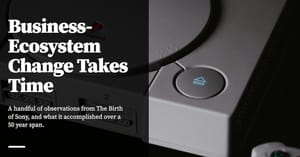This is part 5 of the Principles Sequence, a series on the Ray Dalio book. Read the overall book summary here.
Here's a summary of Chapter 3 of Principles, titled “Be Radically Open-Minded”. Or as I like to put it: “Ways Your Brain Sabotages You, That Bloody Thing”.
Dalio opens by saying this is “probably the most important chapter, because it explains how to get around the two things standing in most people's way of getting what they want out of life.”
The two things are:
- Your ego barrier (that is, the part of your brain that causes you to lie to yourself), and
- Your blind spot barrier (that is, the perspectives and thinking that you cannot see, which stems from your unique strengths.)
The solution to both these barriers is to be ‘radically open minded’, a phrase Dalio uses to refer to a very specific way of thinking.
The Ego Barrier
It's easiest to think of yourself as having two ‘yous’. There's a conscious part of your brain that reasons rationally. And there's the subconscious part that reacts defensively and simplifies; offering excuses and blaming others when you screw things up. When you face criticism, this is the part that reacts in anger, even if intellectually you know that constructive criticism is good for you.
You should feel your ego barrier intuitively. If you've ever seen someone “angry at themselves”, this is their higher brain fighting with their low brain. To use a personal example, I found myself procrastinating for two whole weeks recently when it came to implementing a particularly difficult feature. This experience should be familiar to many of us — just ask any end-of-term college student. After 30 minutes of rather painful meditation (at the prompting of a rather unimpressed friend), I realised I was scared of starting because starting meant possible failure. It turned out this fear had sat below the level of conscious thought for weeks.
Dalio points out that things are even worse when two human beings are talking with each other. Their higher-level brains may want a rational discussion, but if their lower brains are angered, all chance of a productive conversation goes out the window. Worse still, neither party is usually aware of being controlled by their lower brains, perhaps until hours after the fact.
The Blind Spot Barrier
We all have blind spots, which are ideas and perspectives that we can't see because we would never have considered them. These blind spots are the inevitable consequences of our strengths. You've probably seen this in your colleagues: some of them are big-picture thinkers, while others are more detail-oriented. Some are creative, others are organised (and, yes, it does seem the two traits exist at opposite ends of a spectrum!)
This blind spot barrier is most problematic in two situations. The first is when you're disagreeing with someone. Two parties in disagreement typically remain convinced that they're right due to their blind-spots — and often end up angry at each other. This then leads to suboptimal decision making.
The second situation is when you're trying to solve a problem. Most people attempt to figure things out on their own, and thus ‘spin in their own heads’ instead of taking advantage of all the wonderful thinking available to them outside their heads. This suboptimal one-head-problem-solving approach typically looks like someone repeatedly crashing into what they are blind to, until the crashing leads them to adapt. Dalio says this is stupid, because you will save yourself more time if you seek out people who think differently from you and are complementary to your strengths, and rely on them or their thinking instead.
The good news is that blind spots are usually commonly found together. If you make a list of areas in which you've consistently made bad decisions due to blind spots, you can know to watch out for them in the future.
Radical Open Mindedness
I've tried to compress Dalio's ‘radical open mindedness’ into a set of concise principles. (He spreads it out across a few pages). In a nutshell:
- Radical open mindedness is an ability to effectively explore different points of views and different possibilities without letting your ego or blind spots get in the way.
- It's motivated by the genuine worry that you might not be seeing your choices optimally.
- It is implemented in two practices:
- Thoughtful Disagreement — a protocol Dalio has formalised in Bridgewater.
- Triangulation of Views with Believable People Who Are Willing To Disagree — the practice of getting ‘believable people’ to argue with each other in order to triangulate the truth. We'll define believable in a bit.
Before we get to the two practices, its worth it to spend a bit on time to expand on what Dalio means by 'radical open-mindedness'.
Dalio argues that true open-mindedness is the adoption of a couple of principles. You:
- Believe that you might not know the best possible path, and recognise that your ability to deal well with “not knowing” is more important than whatever it is that you do know. This seems obvious so far. The next one is less obvious:
- Recognise that decision making is a two-step process. The first step is to take in all the relevant information, in a state of uncomfortable ‘not knowing’. The second step is to decide. Dalio observes that most people aren't comfortable staying in step one, because they don't like not knowing. They prefer the surety of holding on to their own opinion. When opposing viewpoints are offered that push them back into ‘not knowing’, these people would then say “I want to make up my own mind.” This is suboptimal, as it usually means favouring one's own opinion over that of others. Cultivating this comfort with ‘not knowing’ is key to better decision-making; Dalio proposes thinking of it as “greater and more exciting than actually knowing, because it's a period of discovery”.
- Recognise that to gain the perspective that comes from seeing things through another's eyes, you must suspend judgment for a time — only by empathising can you properly evaluate another point of view. This doesn't mean you go along with what you don't believe in. What it does mean is to consider the reasoning of others instead of holding only to your point of view.
- Remember that you're looking for the best answer, not simply the best answer that you can come up with yourself. The probability of the best answer being in your head is small, after all, compared to it being outside your head. Don't worry about looking good — the goal isn't to come up with the answer yourself, but to win.
And, finally, the most intriguing guideline:
- Be clear on whether you are arguing or seeking to understand and think about which is most appropriate based on your and others’ believability. What is believability? We've covered this in a previous post in the Principles Sequence, but believable people are people who have 1) a record of at least three relevant successes and 2) have great explanations of their approach when probed. If you are discussing an issue with a peer with the same believability as you, it's appropriate to argue. If one person is clearly more knowledgeable than the other, it's preferable for the less believable person to approach the more believable person as a student. In this case, the ‘student’ should make it clear she is asking questions because she is seeking to understand their perspective. Conversely, Dalio recommends the more believable person to politely remind the other of the disparity, and suggest that they ask them questions instead of arguing.
I've not seen this approach anywhere else. Dalio is arguing that you should be open-minded, but selectively so — that is, you should assign believability weightings to alternative viewpoints that clash with your own. He goes further and says you shouldn't waste time debating with people who have lower believability on a topic than you.
I think this is a performance optimisation more than anything else — you can't listen to everyone, after all.
The Practice of Thoughtful Disagreement
Thoughtful disagreement is a protocol for disagreement that Dalio implemented in Bridgewater. We may, of course, adopt the principles behind the protocol for use in our lives.
The goal of thoughtful disagreement is to find out which view is true and decide what to do about it, not to convince the other party that you are right. The motivation behind this practice is the genuine fear of missing important perspectives. Dalio proposes a few best practices:
- Conduct the conversation in a way that conveys that you're just trying to understand.
- Try to keep emotions out of it, and hold the discussion in a calm and dispassionate manner.
- Ask questions more than make statements.
- Remember the motivation — you're not arguing, you're merely exploring what is true.
- Remember that disagreements are not threats, they are opportunities for learning.
- Believe that people who change their minds because they learnt something are the real winners; people who stubbornly refuse to learn are the losers.
- Use the 2 minute rule — in which neither interrupts the other, so that both have time to get all their thoughts out.
- Describe back to the person you are disagreeing with their own perspective.
- And, most importantly: you should be open-minded and assertive at the same time. This means “holding and exploring conflicting possibilities in your mind while moving fluidly toward whatever is likely to be true based on what you learn.”
Dalio warns that this is time-consuming, but worth it provided you prioritise what you spend time on, and who you spend it with. It goes without saying that you shouldn't be open-minded with everyone; you should engage with thoughtful disagreement with only the most believable people you know.
Triangulate Your View With Believable People Who Are Willing To Disagree
There's a second application of being open-minded, and Dalio recommends using it when you're trying to rapidly learn the truth on some thing you're not that familiar with. He proposes that you engage multiple believable people, and then get them to disagree thoughtfully with each other. You can then ask questions to this panel of believable people, in order to rapidly triangulate views to get to the truth.
As an example, he got three different doctors to argue with each other on a phone about their diagnosis in front of him — talk about a high-stakes way of ‘getting a second medical opinion’!
At Bridgewater, Dalio uses the approach when the subject matter is too complex for him to understand in the time required. So he turns over the decision-making to those who are more believable than him, but he still sits in to listen to their thoughtful disagreement.
The difference between closed-minded and open-minded people
This one is a doozy. I've heard stories of Bridgewater seniors attacking new employees for being closed-minded; it does seem Dalio's team makes it a point to systematically root out closed-minded people in the company.
Principles gives us a list of close-minded vs open-minded people. They are as follows:
- Closed-minded people don't want their ideas challenged. They are typically frustrated that they can't get the other person to agree with them instead of curious as to why the other person disagrees. Conversely, open-minded people are curious when there's a disagreement, because they're aware of the possibility that they might be wrong.
- Closed-minded people are more likely to make statements than ask questions. Dalio notes that even the most believable people he knows tend to ask questions more than make statements.
- Closed-minded people focus much more on being understood than on understanding others.
- Closed-minded people say things like “I could be wrong ... but here's my opinion.” This is a common cue that allows people to hold on to their own opinion while convincing themselves that they are being open-minded. Instead, if your statement starts with “I could be wrong”, then you should probably follow it with a question and not an assertion. Open-minded people know when to make statements and when to ask questions.
- Closed-minded people block others from speaking. (Dalio recommends using the 2-minute rule).
- Closed-minded people have trouble holding two thoughts simultaneously in their minds. Open-minded people can take in the thoughts of others without losing the ability to think well — they can hold two or more conflicting concepts in their mind and go back and forth between them to assess their relative merits..
- Closed-minded people lack a deep sense of humility. Humility typically comes from an experience of humiliating failure, which “leads to an enlightened focus on knowing what one doesn't know”.
Reflections On The Chapter
It's funny. I started my reread of Principles thinking that I ‘got this’ — that I had applied most of the recommendations Dalio wrote in the original version of the book, and I believed that my application of his recommendations in the 7 years since was responsible for my achievements so far.
I have come some way: I lie to myself less these days, I've learnt to recognise spikes of pain as signals that something was misaligned with my mental-models, and I've introspected more effectively over the years.
But I read this chapter and recognised myself in more of the closed-minded descriptions above, as compared to the open-minded ones. If you've met me anytime in the last few years, you'd often hear me say “I could be wrong, but ...” and then offer my opinion immediately after. I thought this made me rational and open-minded. I didn't realise it was a marker of closed-mindedness, which it certainly was.
It's an unpleasant surprise to learn I'm nowhere near the ideal Dalio calls for — or at least, nowhere near the ideal that the Bridgewater people have to live with, due to the nature of their work. There's some work for me to do here.
The other thing that I found interesting was this concept of ‘only listening to believable people’ — or rather, applying a believability weightage to advice you get. I've long thought that you should evaluate everyone’s ideas based on the idea itself, not the person making it. But debate isn't decision-making. This is probably more efficient.
Of course, there's the fact that discounting advice from people who you've judged to be low believability compared to you is incredibly satisfying and attractive. Who doesn't want to discount advice from idiots? But it also comes with the caveat that you need to recognise when you're low believability, which is when you're the idiot and that you should shut up.
In the next post, we're going to talk about Dalio's approach to analysing people.
Next: part 6 — Understand that People are Wired Very Differently.
This is part 5 of the Principles Sequence. Subscribe here, or follow the blog on RSS/Twitter.
Originally published , last updated .





